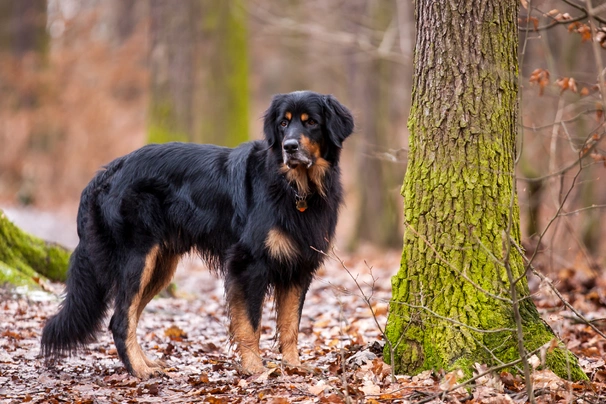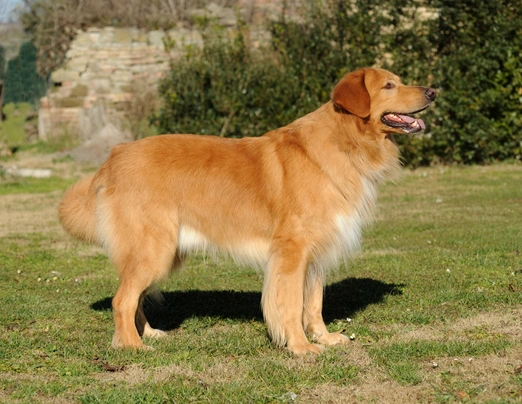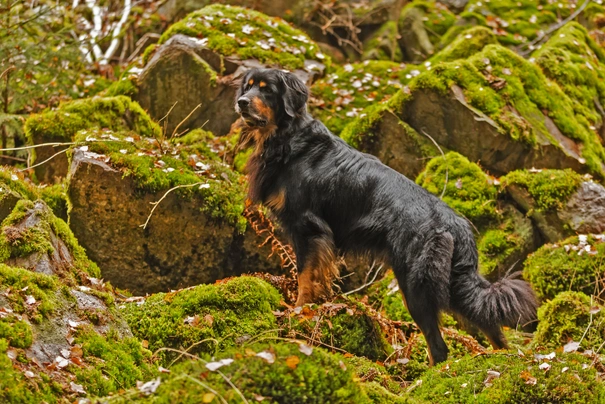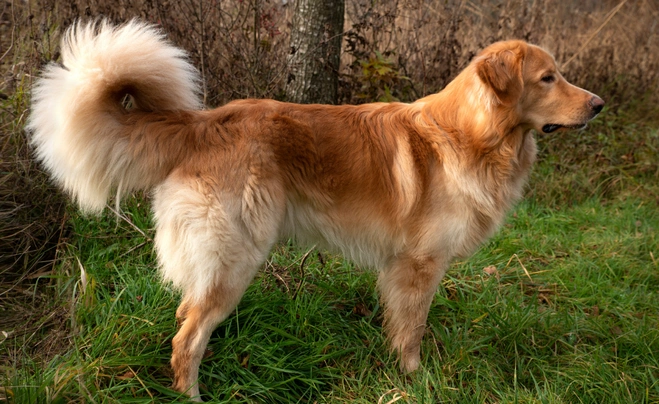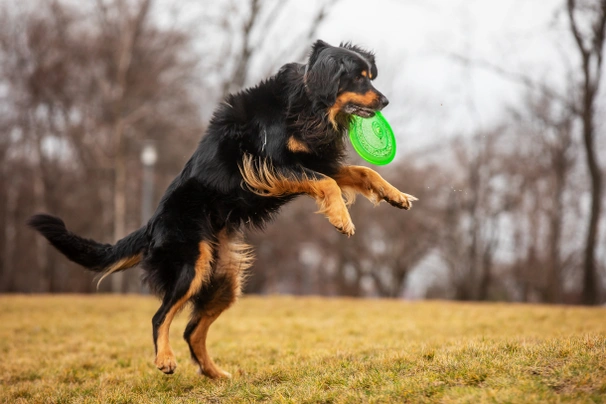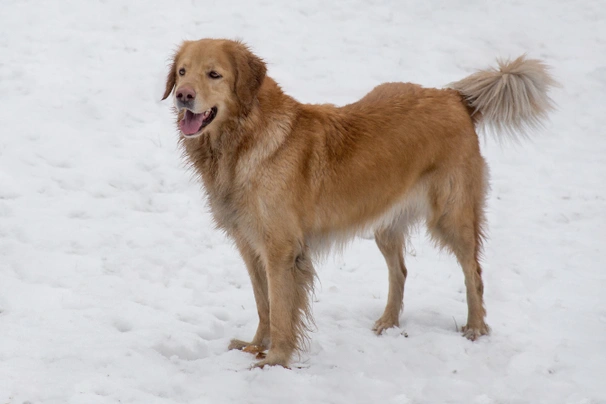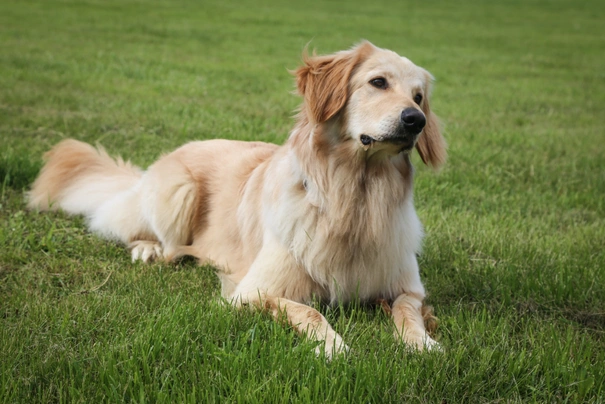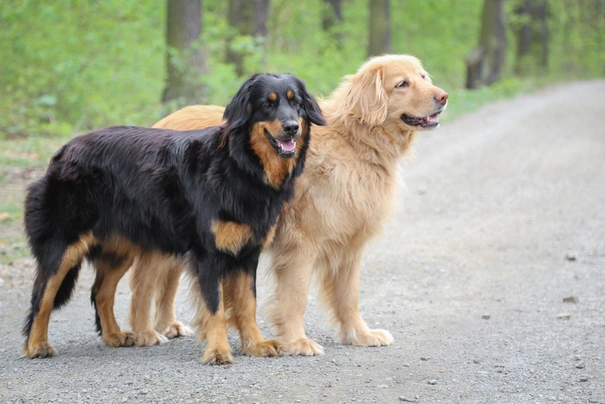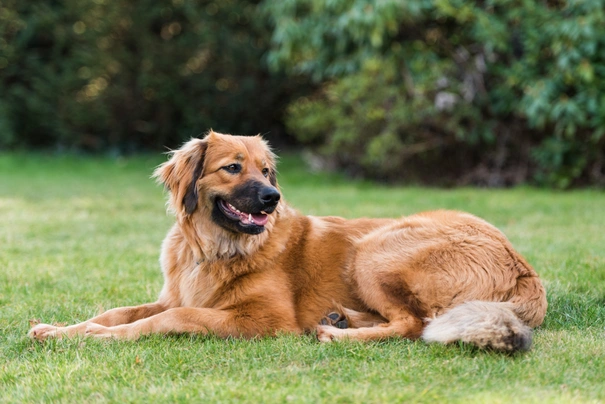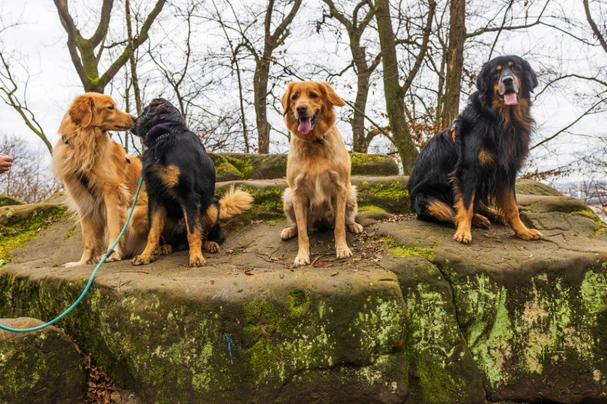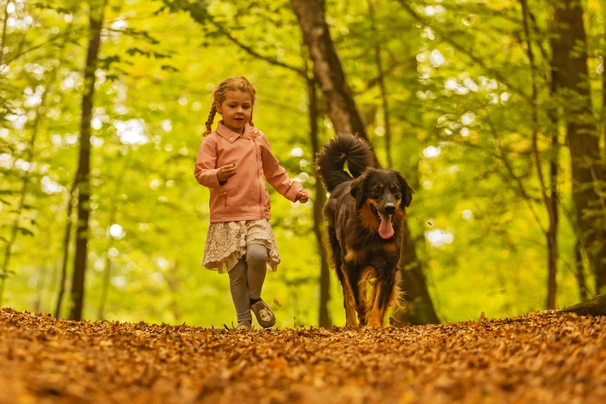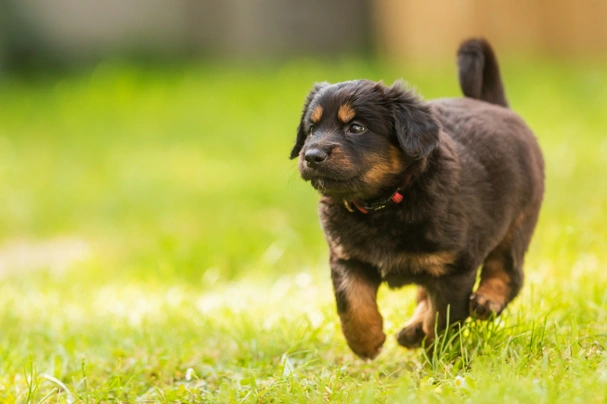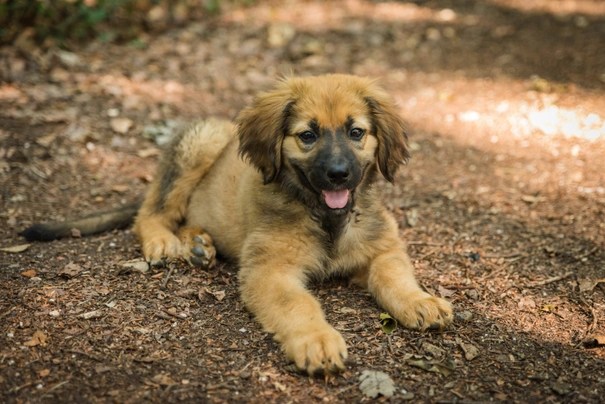Hovawart
Pros
Cons
Introduction of the Hovawart
The Hovawart is native to Germany where they have always been highly prized watchdogs and companions. They belong to an ancient breed of working dog that was once found all over Europe and the Mediterranean. These attractive dogs are similar looking to retrievers and boast having very kind natures being even-tempered reliable and adaptable. Often called Hovies these charming dogs are not as well known in many other countries of the world but slowly more people are getting to know about this ancient breed although they are still rarely seen here in the UK.
Anyone wanting to share a home with a Hovawart would need to register their interest with breeders and go on a waiting list for the pleasure of doing so because few puppies are bred and registered with the Kennel Club every year. The good news is that the wait would be well worth it because Hovies as previously mentioned make wonderful family pets and companions thanks to their kind affectionate and trustworthy natures.
History of the Hovawart
The Hovawart is one of the most ancient breeds on the planet having been bred to guard herds of livestock and castles during the Middle Ages. However over time the breed became extinct and was only recreated through the hard work of Dr Konig a zoologist who decided to revive these handsome dogs at the end of the first World War. He found similar looking dogs in the Black Forest and the Harz regions of the country where original Hovawarts were once found and he bred these dogs to German Shepherds Newfoundlands Leonbergers Hungarian Kuvasz and other breeds until he created dogs that looked like the Hovawarts depicted in paintings and drawing from centuries past.
However there has always been some debate as to whether Konig resurrected the breed or whether he simply created another very similar looking dog. With this said there are those who believe that Hovawarts did actually survive on remote and isolated farms in the more rural regions of the country and that it was these dogs that Konig had discovered and used as the foundation dogs in his breeding programme. In 1937 the breed was officially recognised by the German Kennel Club but remained relatively unknown to the rest of the world.
These handsome dogs were only introduced to the UK in more recent times and are now recognised as a unique breed in its own right by The Kennel Club. However it is often hard to distinguish a Hovawart from other retriever breeds thanks to the fact they look so much alike. With this said they are still very rarely seen here in the UK although they remain an extremely popular choice in their native Germany thanks not only to their charming looks but their placid kind natures too.
Interesting facts about the breed
- Is the Hovawart a vulnerable breed? No although still quite rare in the UK which means that waiting lists tend to be long and puppies can command a lot of money
- Hovawart when translated means “guardian of the property”
- The breed is a relative to an ancient group of working dogs that were found all over Europe and the Mediterranean
- Hovawarts are often mistaken for being other types of retrievers but they are breed in their own right
- Their training has to remain “fun” for them to stay focussed
- They were first bred in the Black Forest and Harz region of Germany
- Hovawarts were originally bred to guard estates and castles
Appearance of the Hovawart
Height at the withers: Males 63 - 70 cm Females 58 - 65 cm
Average weight: Males 30 - 40 kg Females 25 - 35 kg
The Hovawart is a handsome medium sized dog and one that resembles many other retriever types which includes the Golden Retriever. They are often referred to as being "naturally beautiful" because they are so well-balanced and nicely put together. They are powerful having slightly longer bodies than they are tall with a noticeable difference between males and their female counterparts.
They have clean heads with moderately broad skulls and clearly defined yet not too exaggerated stops. They have strong deep muzzles that taper ever so slightly to the nose which boasts well-developed nostrils. Their eyes are a nice oval shape and medium in size being either a dark to medium brown in colour. Dogs always have a keen and intelligent look about their eyes.
Ears are triangular having nicely rounded tips and they hang loosely each side of a dog's head being set moderately high. Dogs carry their ears a little forward when excited or alert. The Hovie has a strong jaw with a perfect scissor bite where their upper teeth neatly overlap their lower ones. They have strong well-muscled necks with no dewlap. Front legs are powerful and well-muscled with dogs having well laid-back long shoulders.
They have well balanced bodies and nice strong and level toplines. Chests are broad deep and strong with dogs having well sprung ribs and nice deep briskets. Bellies are moderately tucked up which adds to their athletic appearance. Croups are moderately long and slightly sloping. Their back legs are well muscled and powerful with dogs having extremely well-muscled second thighs. Feet are quite compact and round with well arched toes and nice strong thick pads. Their tails are long and well covered in hair which dogs carry down when at rest but raised over their backs when on the move or excited.
When it comes to their coat the Hovawart boasts having a longish dense close lying top coat that can either be straight or wavy with a slight undercoat. The hair on a dog's head and on the front of their legs is short whereas it’s a long longer on their chests bellies backs of their front legs and back of their thighs and tail. The accepted breed colours for Kennel Club registration are as follows:
- Black
- Black and gold
- Blonde
It is worth noting that the accepted breed colours for Kennel Club registration can differ from those set out in the breed standard which are as follows:
- Black – deep and shiny with no sign of “rustiness”. Dogs can have some white spots on chest and some on their toes and tips of tails with black pigmentation around their eye rims lips and pads
- Blonde – medium shade and shiny being lighter on a dog’s legs and belly. Dogs can have some white spots on chests and some on their toes and tips of their tails with black pigmentation around eye rims lips and pads. Dogs may have a “snow” nose which is acceptable under the Kennel Club breed standard
- Black/gold – deep shiny black with no sign of rustiness and moderate blonde clearly defined markings over each eye on cheeks a strip on each side of muzzle but not on bridge of nose on throat with 2 clear patches on each side of breastbone on forelegs with colour running from toes to wrists up the back of the forearms and down to a dog’s elbows on back legs colour running from toes to hocks right up the inside of legs and when viewed from the side it is a narrow stripe up a dog’s legs that reaches to their stifle and belly under tail. Dogs can have some white spots on their chests and some on their toes and tips of their tails with black pigmentation on eye rims lips and paw pads
Gait/movement
When a Hovawart moves they do so with an effortless stride covering a lot of ground when they do and showing lots of drive and a good reach.
Faults
The Kennel Club frowns on any exaggerations or departures from the breed standard and would judge the faults on how much they affect a dog's overall health and wellbeing as well as their ability to perform.
Males should have both testicles fully descended into their scrotums and it is worth noting that a dog can be a little lighter or heavier as well as slightly taller or shorter than set out in the Kennel Club breed standard which is only given as a guideline.
Temperament of the Hovawart
Hovawarts are known to be outgoing confident characters. They are intelligent with the added bonus being they like to please which in short means in the right hands and environment a Hovie is easy to train. However they need to be well socialised from a young enough age for them to grow into more outgoing adult dogs remembering that Hovawarts tend to mature a lot later than many other breeds which is usually when they are around 2 years old. As such they retain their puppy-like traits for much longer which is just one of the reasons these dogs are such a pleasure to have around.
Being so intelligent the Hovawart learns new things very quickly with the downside being they are just as quick to pick up "bad" habits too. They are known to be energetic and have a natural curiosity about everything that goes on around them. They are also very quick witted which is one of the reasons they need to be taught the "basics" when they are young. Once a puppy has been fully vaccinated it's a good idea to enrol them into puppy classes which is a great way of starting their training in earnest with the added bonus being they get to meet lots of other dogs and people which goes a long way in socialising these highly intelligent and quick-witted dogs.
They are a good choice for first time owners as long as people have enough time to dedicate to such a high energy and smart canine companion. Once a Hovie forms a strong bond with their family they remain totally devoted to them and will not hesitate in protecting them and their property if they ever feel it necessary to do so. There is a downside to this which is that they do not like to be left for too long on their own preferring to be in the company of their owners. As such they are a great choice for families where one person usually stays at home when everyone else is out of the house.
They tend to be naturally wary of people they don't know however rarely would a Hovie show any sort of aggressive behaviour towards a stranger preferring to keep their distance until they get to know them. However if they feel threatened in any way they will stand their ground and protect their families and their property.
Are they a good choice for first time owners?
Hovawarts are a great choice for first time dog owners because they are so amenable and people-oriented loving nothing more than to please and to entertain their families. They are particularly good with young children and older people too although playtime can get a bit boisterous at times.
What about prey drive?
Hovawarts are very social by nature and as such they do not have a very high prey drive. However this is not to say that a dog would not give chase to a smaller animal when the mood takes them and this includes squirrels and the cat from next door.
What about playfulness?
Hovawarts have a very playful side to their natures and love to entertain and be entertained. They are known to be a little mischievous when the mood takes them and being so clever a dog quickly learns what pleases their owners and how to get their own way when they want something.
What about adaptability?
Hovawarts are better suited to households with well-fenced secure back gardens that a dog can safely roam in whenever possible to really let off steam. They have quite a low boredom threshold and enjoy being out and about as much as possible.
What about separation anxiety?
Although Hovawarts form strong ties with their families they are not generally known to suffer from separation anxiety although no dog likes to be left to their own devices for long periods of time which could result in them developing some unwanted and destructive behaviours around the home.
What about excessive barking?
Some Hovawarts like the sound of their own voices a little too much which is something that needs to be gently nipped in the bud when a dog is still young being careful not to frighten them. Others will only bark when there are strangers about or when something they don't like is going on in their surroundings.
Do Hovawarts like water?
Most Hovawarts love swimming and will take to the water whenever they can more especially when the weather is hot. However if anyone who owns a dog that does not like water should never force them to go in because it would just end up scaring them. With this said care should always be taken when walking a dog off the lead anywhere near more dangerous watercourses just in case a dog decides to leap in and then needs rescuing because they cannot get out of the water on their own.
Are Hovawarts good watchdogs?
Hovawarts are natural watchdogs because they are always on the alert but rarely would a dog show any sort of aggressive behaviour preferring to stand their ground and bark to alert an owner to something they don’t like that might be going on.
Intelligence / Trainability of the Hovawart
Hovawarts are intelligent and they like to please which means in the right hands and with the proper socialisation they are easy to train and enjoy nothing more than the attention they are given during training sessions. The key to successfully training one of these quick-witted dogs is to start their training as early as possible beginning with the basics before moving on to the harder things.
It pays to keep training sessions short and as interesting as possible so that dogs remain focussed and therefore stand a better chance of understanding what is being asked of them. Longer repetitive training sessions do not work with Hovies because they get bored so quickly. It’s also important to bear in mind that they mature a lot slower than many other breeds which means it can be hard to keep them focussed when anything else is going on around them.
They do not respond well to harsh correction or heavy-handed training methods because they are quite sensitive dogs by nature. They do respond extremely well to positive reinforcement training methods which always brings the best out of these smart quick witted dogs.
Like all puppies Hovawarts are incredibly cute when young and it is all too easy to spoil them when they first arrive in new homes. As soon as a puppy is nicely settled owners must start out as they mean to go on by laying down ground rules and boundaries so that a puppy understands what is expected of them. It helps establish a pecking order and who the alpha dog is in the household. The first commands a puppy should be taught are as follows:
- Come
- Sit
- Stay
- Heel
- Quiet
- Leave it
- Down
- Bed
Children and other
Hovies thrive in a family environment and more especially in households where the children a slightly older and who therefore know how to behave around dogs. As such any interaction between toddlers and a dog should always be well supervised to make sure playtime does not get too boisterous which could result in a smaller child being knocked over albeit by accident.
When well socialised from a young enough age they generally get on well with other dogs they meet. They are also good around smaller animals and pets especially if they have grown up in the same household and this includes family cats although a Hovie might enjoy chasing off the neighbour's cat whenever they get the chance.
Health of the Hovawart
The average life expectancy of a Hovawart is between 10 and 14 years when properly cared for and fed an appropriate good quality diet to suit their ages.
Like so many other breeds the Hovie is known to suffer from a few hereditary health issues which are worth knowing about if you are planning share your home with one of these active and good-looking dogs. The conditions that seem to affect the breed the most include the following:
- Hip dysplasia (HD) – dogs should be hip scored under the BVA/KC hip dysplasia scheme with the breed mean score being 10.4 with parent dogs having a lower score
- Degenerative Myelopathy (DM) – test available through the Animal Health Trust (AHT)
- Hypothyroidism
- Osteochondritis dissecans
- Dilated cardiomyopathy (DCM)
- Bloat/gastric torsion
It is worth noting that breed average COI with The UK Kennel Club current stands at 0.0%.
What about vaccinations?
Hovawart puppies would have been given their initial vaccinations before being sold but it is up to their new owners to make sure they have their follow-up shots in a timely manner with the vaccination schedule for puppies being as follows:
- 10 -12 weeks old bearing in mind that a puppy would not have full protection straight away but would be fully protected 2 weeks after they have had their second vaccination
There has been a lot of discussion about the need for dogs to have boosters. As such it's best to talk to a vet before making a final decision on whether a dog should continue to have annual vaccinations which are known as boosters.
What about spaying and neutering?
A lot of vets these days recommend waiting until dogs are slightly older before spaying and neutering them which means they are more mature before undergoing the procedures. As such they advise neutering males and spaying females when they are between the ages of 6 to 9 months old and sometimes even when a dog is 12 months old.
Other vets recommend spaying and neutering dogs when they are 6 months old but never any earlier unless for medical reasons. With this said many breeds are different and it is always advisable to discuss things with a vet and then follow their advice on when a dog should be spayed or neutered.
What about obesity problems?
As with other breeds some Hovawarts gain weight after they have been spayed or neutered and it's important to keep an eye on a dog's waistline just in case they do. If a dog starts to put on weight it's important to adjust their daily calorie intake and to up the amount of exercise they are given. Older dogs too are more prone to gaining weight and again it's essential they be fed and exercised accordingly because obesity can shorten a dog's life by several years. The reason being that it puts a lot of extra strain on a dog's internal organs including the heart which could prove fatal.
What about allergies?
Hovawarts are not known to suffer from allergies but it's important for a dog to see a vet sooner rather than later if one flares up. Allergies can be notoriously hard to clear up and finding the triggers can be challenging. With this said a vet would be able to make a dog with an allergy more comfortable while they try to find out the triggers which could include the following:
- Certain dog foods that contain high levels of grains and other cereal-type fillers
- Airborne pollens
- Dust mites
- Environment
- Flea and tick bites
- Chemicals found in everyday household cleaning products
Participating in health schemes
All responsible Hovawart breeders would ensure that their stud dogs are tested for known hereditary and congenital health issues known to affect the breed by using the following schemes:
- Hip dysplasia through the BVA/KC scheme
- Thyroid function test through the breed club
- Degenerative Myelopathy (DM) – test available through the Animal Health Trust (AHT)
What about breed specific breeding restrictions?
Apart from the standard breeding restrictions that are in place for all Kennel Club registered breeds there are no other breed specific breeding restrictions in place for the Hovawart.
What about Assured Breeder Requirements?
It is mandatory for all Kennel Club Assured Breeders use the following test on stud dogs and all other breeders are strongly advised to follow suit:
The Kennel Club also strongly recommends that all breeders use the following test on stud dogs:
- Breed Club - Thyroid function test
Caring for the Hovawart
As with any other breed Hovawarts need to be groomed on a regular basis to make sure their coats and skin are kept in top condition. They also need to be given regular daily exercise to ensure they remain fit and healthy. On top of this dogs need to be fed good quality food that meets all their nutritional needs throughout their lives.
Caring for a Hovawart puppy
Hovawart puppies are boisterous and full of life which means it's essential for homes and gardens to be puppy-proofed well in advance of their arrival. A responsible breeder would have well socialised their puppies which always leads to more outgoing confident and friendly dogs right from the word go. With this said any puppy is going to feel vulnerable when they leave their mother and littermates which must be taken into account. The longer a puppy can remain with their mother the better although it should never be for too long either.
It's best to pick a puppy up when people are going to be around for the first week or so which is the time needed for a puppy to settle in. Puppy-proofing the home and garden means putting away any tools and other implements that a boisterous puppy might injure themselves on. Electric wires and cables must be put out of their reach because puppies love chewing on things. Toxic plants should be removed from flowerbeds and the home too.
Puppies need to sleep a lot to grow and develop as they should which means setting up a quiet area that's not too out of the way means they can retreat to it when they want to nap and it's important not to disturb them when they are sleeping. It's also a good idea to keep "playtime" nice and calm inside the house and to have a more active "playtime" outside in the garden which means puppies quickly learn to be less boisterous when they are inside.
The documentation a breeder provides for a puppy must have all the details of their worming date and the product used as well as the information relating to their microchip. It is essential for puppies to be wormed again keeping to a schedule which is as follows:
- Puppies should be wormed at 6 months old
- They need to be wormed again when they are 8 months old
- Puppies should be wormed when they are 10 months old
- They need to be wormed when they are 12 months old
Things you'll need for your puppy
There are certain items that new owners need to already have in the home prior to bringing a new puppy home. It's often a good idea to restrict how much space a puppy plays in more especially when you can't keep an eye on what they get up to bearing in mind that puppies are often quite boisterous which means investing in puppy gates or a large enough playpen that allows a puppy the room to express themselves while keeping them safe too. The items needed are therefore as follows:
- Good quality puppy or baby gates to fit on doors
- A good well-made playpen that's large enough for a puppy to play in so they can really express themselves as puppies like to do
- Lots of well-made toys which must include good quality chews suitable for puppies to gnaw on bearing in mind that a puppy will start teething anything from when they are 3 to 8 months old
- Good quality feed and water bowls which ideally should be ceramic rather than plastic or metal
- A grooming glove
- A slicker brush or soft bristle brush
- Dog specific toothpaste and a toothbrush
- Scissors with rounded ends
- Nail clippers
- Puppy shampoo and conditioner which must be specifically formulated for use on dogs
- A well-made dog collar or harness
- A couple of strong dog leads
- A well-made dog bed that's not too small or too big
- A well-made dog crate for use in the car and in the home that's large enough for a puppy to move around in
- Baby blankets to put in your puppy's crate and in their beds for when they want to nap or go to sleep at night
Keeping the noise down
All puppies are sensitive to noise including Hovawart puppies. It's important to keep the noise levels down when a new puppy arrives in the home. TVs and music should not be played too loud which could end up stressing a small puppy out resulting in them being withdrawn timid and shy.
Keeping vet appointments
As previously mentioned Hovawart puppies would have been given their first vaccinations by the breeders but they must have their follow up shots which is up to their new owners to organise. The vaccination schedule for puppies is as follows:
- 10 -12 weeks old bearing in mind that a puppy would not have full protection straight away but would only be fully protected 2 weeks after they have had their second vaccination
When it comes to boosters it's best to discuss these with a vet because there is a lot of debate about whether a dog really needs them after a certain time. However if a dog ever needed to go into kennels their vaccinations would need to be fully up to date.
What about older Hovawarts when they reach their senior years?
Older Hovawarts need lots of special care because as they reach their golden years they are more at risk of developing certain health concerns. Physically a dog's muzzle may start to go grey but there will be other noticeable changes too which includes the following:
- Coats become coarser
- A loss of muscle tone
- They can either become overweight or underweight
- They have reduced strength and stamina
- Older dogs have difficulty regulating their body temperature
- They often develop arthritis
- Immune systems do not work as efficiently as they once did which means dogs are more susceptible to infections
- Older dogs change mentally too which means their response time tends to be slower as such they develop the following:
- They respond less to external stimuli due to impaired vision or hearing
- They tend to be a little pickier about their food
- They have a lower pain threshold
- Become intolerant of any change
- Often an older dog can feel disorientated
Living with a Hovawart in their golden years means taking on a few more responsibilities but these are easily managed and should include looking at their diet the amount of exercise they are given how often their dog beds need changing and keeping an eye on the condition of their teeth.
Older dogs need to be fed a good quality diet that meets their needs at this stage of their lives all the while keeping a close eye on a dog's weight. A rough feeding guide for older dogs is as follows bearing in mind they should be fed highly digestible food that does not contain any additives:
- Protein content should be anything from 14 – 21%
- Fat content should be less than 10%
- Fibre content should be less than 4%
- Calcium content should be 0.5 – 0.8%
- Phosphorous content should be 0.4 – 0.7%
- Sodium content should be 0.2 – 0.4%
Older Hovawarts don't need the same amount of daily exercise as a younger dog but they still need the right amount of physical activity to maintain muscle tone and to prevent a dog from putting on too much weight. All dogs need access to fresh clean water and this is especially true of older dogs when they reach their golden years because they are more at risk of developing kidney disorders.
Grooming of the Hovawart
Hovies have moderately long and thick top coats with a slight undercoat that's softer than their outercoat. They shed quite a lot throughout the year only more so during the Spring and then again in the Autumn when more frequent grooming is usually necessary to remove dead and loose hair. However at other times of the year all they need is a brush two to three times a week to prevent any matts or tangles from forming paying particular attention to a dog's chest their belly and the backs of their legs and tails where the hair tends to be that much longer.
It's also important to check a dog's ears on a regular basis and to clean them when necessary. If too much wax is allowed to build up in a dog's ears it can lead to a painful infection which can be hard to clear up. In short prevention is often easier than cure when it comes to ear infections.
Exercise of the Hovawart
The Hovawart is a high energy intelligent dog and as such they need to be given the right amount of daily exercise and mental stimulation for them to be truly happy well-rounded dogs. As such they need at least 2 hour's exercise a day with as much off the lead time as possible. If they are not given the right amount of mental stimulation and exercise every day a Hovie would quickly get bored and could even begin to show some destructive behaviours around the home.
A shorter walk in the morning would be fine but a longer more interesting one in the afternoon is a must. These dogs also like to be able to roam around a back garden as often as possible so they can really let off steam. However the fencing has to be extremely secure to keep these high energy dogs in because if they find a weakness in the fence they will soon escape out and get into all sorts of trouble.
With this said Hovie puppies should not be over exercised because their joints and bones are still growing. This includes not letting a dog jump up and down from furniture or going up or down the stairs. Too much pressure placed on their joints and spines at an early age could result in a dog developing serious problems later in their lives**.**
Feeding of the Hovawart
If you get a Hovi puppy from a breeder they would give you a feeding schedule and it's important to stick to the same routine feeding the same puppy food to avoid any tummy upsets. You can change a puppy's diet but this needs to be done very gradually always making sure they don't develop any digestive upsets and if they do it's best to put them back on their original diet and to discuss things with the vet before attempting to change it again.
Older dogs are not known to be fussy eaters but this does not mean they can be fed a lower quality diet. It's best to feed a mature dog twice a day once in the morning and then again in the evening making sure it's good quality food that meets all their nutritional requirements. It's also important that dogs are given the right amount of exercise so they burn off any excess calories or they might gain too much weight which can lead to all sorts of health issues. Obesity can shorten a dog's life by several years so it's important to keep an eye on their waistline from the word go.
Because Hovies have been known to suffer from bloat it is really important for them to be fed twice a day instead of giving them one large meal a day. It's also a good idea to invest in a stand for their feed bowls which makes it easier for these large dogs to eat comfortably without having to stretch their necks to reach their food. Dogs should never be exercised just before or just after they have eaten either because this puts them more at risk of suffering from gastric torsion.
Feeding guide for a Hovawart puppy
Puppies need to be fed a highly nutritious good quality diet for them to develop and grow as they should. As a rough guide a Hovawart puppy can be fed the following amounts every day making sure their meals are evenly spread out throughout the day and it's best to feed them 3 or 4 times a day:
- 2 months old - 265g to 287g depending on a puppy's build
- 3 months old - 327g to 384g depending on a puppy's build
- 4 months old - 354g to 425g depending on a puppy's build
- 6 months old - 405g to 579g depending on a puppy's build
- 8 months old - 404g to 624g depending on a puppy's build
- 10 months old - 370g to 583g depending on a puppy's build
- 12 months old - 334g to 482g depending on a puppy's build
- 14 months old - 331g to 473g depending on a puppy's build
Once a dog is 16 months old they can be fed adult food.
Feeding guide for an adult Hovawart
Once fully mature an adult Hovawart should be fed a good quality diet to ensure their continued good health. As a rough guide an adult dog can be fed the following amounts every day:
- Dogs weighing 25 kg can be fed 285 g to 435 g a day depending on activity and build
- Dogs weighing 30 kg can be fed 318 g to 485 g a day depending on activity and build
- Dogs weighing 35 kg can be fed 364 g to 556 g a day depending on activity and build
- Dogs weighing 40 kg can be fed 394 g to 601 g a day depending on activity and build
Hovawart price
If you are looking to buy a Hovawart you would need to register your interest with breeders and agree to being put on a waiting list because very few puppies are bred and registered with The Kennel Club every year. You would need to pay anything upwards of £600 for a well-bred pedigree puppy.
The cost of insuring a male 3-year-old Hovie in northern England would be £24.32 a month for basic cover but for a lifetime policy this would set you back £53.97 a month (quote as of October 2018). When insurance companies calculate a pet's premium they factor in several things which includes where you live in the UK a dog's age and whether they have been neutered or spayed among other things.
When it comes to food costs you need to buy the best quality food whether wet or dry making sure it suits the different stages of a dog’s life. This would set you back between £40 - £50 a month. On top of this you need to factor in veterinary costs if you want to share your home with a Hovawart and this includes their initial vaccinations their annual boosters the cost of neutering or spaying a dog when the time is right and their yearly health checks all of which quickly adds up to over £1000 a year.
As a rough guide the average cost to keep and care for a Hovawart would be between £70 to £110 a month depending on the level of insurance cover you opt to buy for your dog but this does not include the initial cost of buying a well-bred healthy Kennel Club pedigree Hovawart puppy.
Buying advice
When visiting and buying any puppy or dog there are many important things to consider and questions to ask of the breeder/seller. You can read our generic puppy/dog advice here which includes making sure you see the puppy with its mother and to verify that the dog has been wormed and microchipped.
Finding well-bred Hovawarts in the UK can prove challenging and waiting lists tend to be long which means that well-bred puppies can often command a lot of money. As such with Hovawarts there is specific advice questions and protocols to follow when buying a puppy which are as follows:
- Prospective owners may find online and other adverts showing images of adorable Hovawart puppies for sale. However the sellers ask buyers for money up front before agreeing to deliver a puppy to a new home. Potential buyers should never buy a puppy unseen and should never pay a deposit to a seller before collecting a puppy from them
- As previously touched upon Hovawarts are rare in the UK and waiting lists are long. As such some amateur breeders/people breed from a dam far too often so they can make a quick profit without caring for the welfare of the puppies their dam or the breed in general. Under Kennel Club rules a dam can only produce 4 litters and she must be between a certain age to do so. Anyone wishing to buy a puppy should think very carefully about who they purchase their puppy from and should always ask to see the relevant paperwork pertaining to a puppy's lineage their vaccinations and their microchipping
